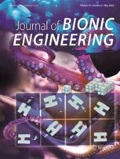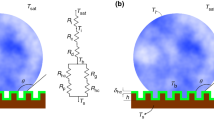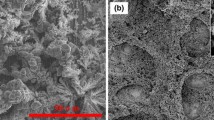Abstract
In the present study, we investigated the evaporation process and deposition pattern of saline droplet on a copper substrate with different roughness under 40 °C ambient temperature. These four substrates are classified as smooth surface and rough surface based on their droplet contact angles. It has been found in this study that the evaporation pattern of droplets has a strong relationship to substrate roughness. The thickness boundary of the evaporation pattern on a smooth surface is larger than that on a rough surface and the particles are closer to boundary and the tendency is more obvious on a smooth surface. The below factors contribute to the result. On the smooth surface, the contact angle of droplet increases as the roughness decreases. On the rough surface, the contact angle increases as the roughness increases. With contact angle decreasing, the evaporation rate at the boundary increases leading to the particles at the boundary more easily sedimentate. Moreover, the capillary flow is hindered by increasing the substrate roughness, while the Marangoni flow remains constant, resulting in more particles remain in the center of the droplet on the rough surface. To sum up, the coffee-ring formation is suppressed by increasing the substrate roughness on a copper substrate under 40 °C temperature.
Similar content being viewed by others
References
Larson R G. Re-shaping the coffee ring. Angewandte Chemie International Edition, 2012, 51, 2546–2548.
Ma H M, Hao J C. Ordered patterns superlattices honeycomb structures and coffee rings. Chemical Society Reviews, 2011, 40, 5457–5471.
Jung Y C, Bhushan B. Mechanically durable carbon nanotube-Composite hierarchical structures with superhydrophobicity, self-cleaning, and low-drag. American Chemical Society Nano, 2009, 3, 4155–4163.
Liu M J, Wang S T, Wei Z X, Song Y L, Jiang L. Bioinspired design of a superoleophobic and low adhesive water/solid interface. Advanced Materials, 2009, 21, 665–559.
Taylor R A, Phelan P E, Otanicar T, Adrian R J, Prasher R S. Vapor generation in a nanoparticle liquid suspension using a focused, continuous laser. Applied Physics Letters, 2009, 95, 161907.
Hu H, Larson R G. Evaporation of a sessile droplet on a substrate. The Journal of Physical Chemistry B, 2002, 106, 1334–1344.
Deegan R D, Bakajin O, Dupont T F, Huber G, Nagel S R, Witten T A. Capillary flow as the cause of ring stains from dried liquid drops. Nature, 1997, 389, 827–829.
Soltman D, Subramanian V. Inkjet-printed line morphologies and temperature control of the coffee ring effect. Langmuir, 2008, 24, 2224–2231.
Bhattacharya P, Samanta A N, Chakraborty S. Sprayevaporative cooling to achieve ultra-fast cooling in runout table. International Journal of Thermal Sciences, 2009, 48, 1741–1747.
Zeng H B, Kristiansen K, Wang P, Bergli J, Israelachvili J. Surface-induced patterns from evaporating droplets of aqueous carbon nanotube dispersions. Langmuir, 2011, 27, 7163–7167.
Pirrung M C. How to make a DNA chip. Angewandte Chemie International Edition, 2002, 41, 1276–1289.
Parisse F, Allain C. Shape changes of colloidal suspension droplets during drying. Journal of Physics, 1996, 6, 1111–1119.
Deegan R D, Bakajin O, Dupont T F, Huber G, Nagel S R, Witten A T. Capillary flow as the cause of ring stains from dried liquid drops. Nature, 1997, 389, 827–829.
Mampallil D, Eral H B. A review on suppression and utilization of the coffee-ring effect. Advances in Colloid and Interface Science, 2018, 252, 38–54.
Parisse F, Allain C. Drying of colloidal suspension droplets: Experimental study and profile renormalization. Langmuir, 1997, 13, 3598–3602.
Marín A G, Gelderblom H, Lohse D, Snoeijer J H. Order-to-disorder transition in ring-shaped colloidal stains. Physical Review Letters, 2011, 107, 085502.
Davis S H. Thermocapillary instabilities. Annual Review of Fluid Mechanics, 1987, 19, 403.
Hu H, Larson R G. Marangoni effect reverses coffee-ring depositions. The Journal of Physical Chemistry B, 2006, 110, 7090–7094.
Bhardwaj R, Fang X, Somasundaran P, Attinger D. Self-assembly of colloidal particles from evaporating droplets: Role of DLVO interactions and proposition of a phase diagram. Langmuir, 2010, 26, 7833–7842.
Yunker P J, Lohr M A, Still T, Borodin A, Durian D J, Yodh A G. Effects of particle shape on growth dynamics at edges of evaporating drops of colloidal suspensions. Physical Review Letter, 2013, 110, 035501.
Ristenpart W D, Kim P G, Domingues C, Wan J, Stone H A. Influence of substrate conductivity on circulation reversal in evaporating drops. Physical Review Letter, 2007, 99, 234502.
Kosmulski M. The pH-dependent surface charging and the points of zero charge. Journal of Colloid Interface Science, 2002, 253, 77–87.
Hyoundsoo K, Francois B, Eujin U, Ian J, Ernie B, Howard A S. Controlled uniform coating from the interplay of Marangoni flows and surface-adsorbed macromolecules. Physical Review Letters, 2016, 116, 124501.
Mampallil D, Eral H B, van den Ende D, Mugele F. Control of evaporating complex fluids through electrowetting. The Royal Society of Chemistry, 2012, 8, 10614–10617.
Chon C H, Paik S, Tipton J B, Kihm K D. Effect of nanoparticle sizes and number densities on the evaporation and dryout characteristics for strongly pinned nanofluid droplets. Langmuir, 2007, 23, 2953–2960.
Zhang Y J, Chen X B, Liu F G, Li L, Dai J, Liu T. Enhanced coffee-ring effect via substrate roughness in evaporation of colloidal droplets. Advances in Condensed Matter Physics, 2018, 9795654.
Gong W, Yan Y Y, Chen S, Giddings D. Numerical study of wetting transitions on biomimetic surface using a lattice Boltzmann approach with large density ratio. Journal of Bionic Engineering, 2017, 14, 486–496.
Zu Y Q, Yan Y Y, Li J Q, Han Z W. Wetting behaviors of a single droplet on biomimetic micro structured surfaces. Journal of Bionic Engineering, 2010, 7, 191–198.
Bormashenko E, Musin A, Zinigrad M. Evaporation of droplets on strongly and weakly pinning surfaces and dynamic of triple line. Colloids and Surface A, 2011, 385, 235–240.
Pittoni P G, Chang C C, Yu T S, Lin S Y. Evaporation of water drops on polymer surfaces: Pinning, depinning and dynamics of the triple line. Colloids and Surface A, 2013, 432, 89–98.
Li Y F, Sheng Y J, Tsao H K. Evaporation stains: Suppressing the coffee-ring effect by contact angle hysteresis. Langmuir, 2013, 29, 7802–7811.
Eral H B, Mannetje D J C M, Oh J M. Contact angle hysteresis: A review of fundamentals and applications. Colloid Polymer Science, 2013, 291, 247–260.
Kovalchuk N M, Trybala A, Starov V M. Evaporation of sessile droplet. Current Opinion in Colloid & Interface Science, 2014, 19, 336–342.
Pham T, Kumar S. Imbibition and evaporation of droplets of colloidal suspensions on permeable substrates. Physical Review Fluids, 2019, 4, 034004.
Pham T, Kumar S. Drying of droplets of colloidal suspensions on rough substrates. Langmuir, 2017, 33, 10061–10076.
Zhang Y J, Qian Y M, Liu Z T, Li Z H, Zang D Y. Surface wringkling and cracking dynamics in the drying of colloidal droplets. The European Physical Journal E, 2014, 37, 84.
Lohani D, Sarkar S. Nanoscale topographical fluctuations: A key factor for evaporative colloidal self-assembly. Langmuir, 2018, 34, 12751–12758.
Smith M I, Sharp J S. Effect of substrate constraint on crack pattern formation in thin films of colloidal polystyrene particles. Langmuir, 2011, 27, 8009–8017.
Darbha K G, Fischer C, Michler A, Luetzenkirchen J, Schäfer T, Heberling F, Schild D. Deposition of latex colloids at rough mineral surfaces: An analogue study using nanopatterned surfaces. Langmuir, 2012, 28, 6606–6617.
Zhang D Y, Tarafdar S, Tarasevich Y Y, Choudhury M D, Dutta T. Evaporation of a droplet: From physics to application. Physics Reports, 2019, 804, 1–56.
Chen X M, Ma R Y, Li J T, Hao C L, Guo W, Luk B L, Li S C, Yao S H, Wang Z K. Evaporation of droplets on superhydrophobic surfaces: Surface roughness and small droplet size effects. Physical Review Letters, 2012, 109, 116101.
Acknowledgment
This work is supported by European Union project H2020 - MSCA - RISE 778104.
Author information
Authors and Affiliations
Corresponding author
Rights and permissions
About this article
Cite this article
Wang, X., Liu, Z., Wang, L. et al. Investigation of Droplet Evaporation on Copper Substrate with Different Roughness. J Bionic Eng 17, 835–842 (2020). https://doi.org/10.1007/s42235-020-0069-5
Published:
Issue Date:
DOI: https://doi.org/10.1007/s42235-020-0069-5




